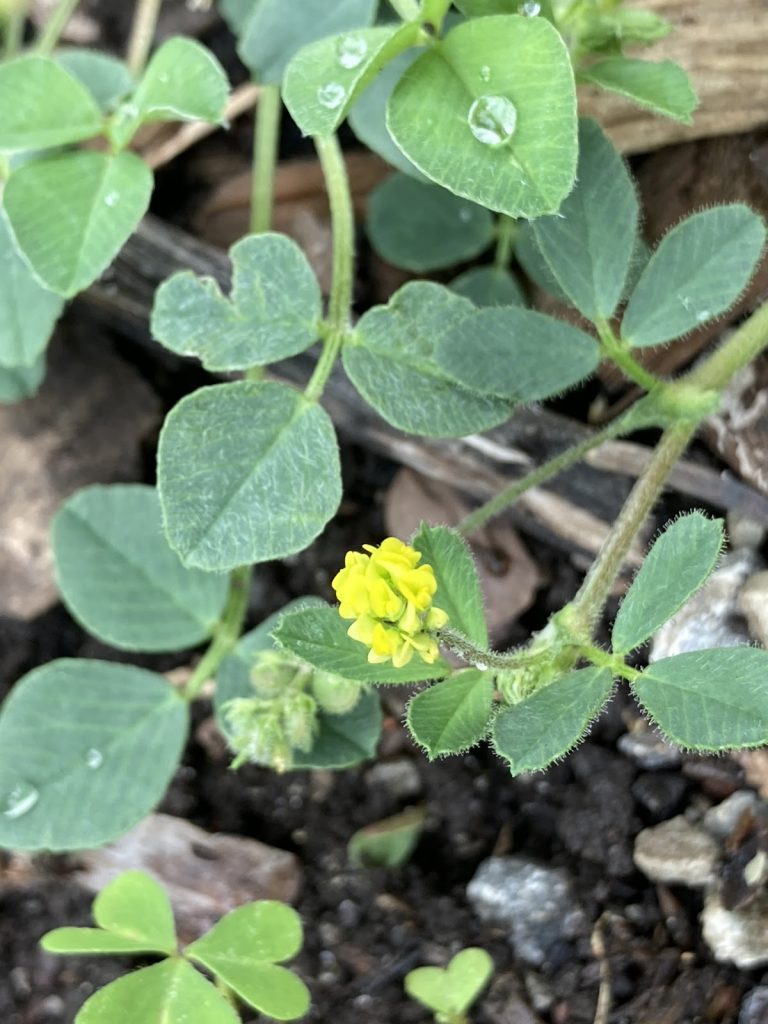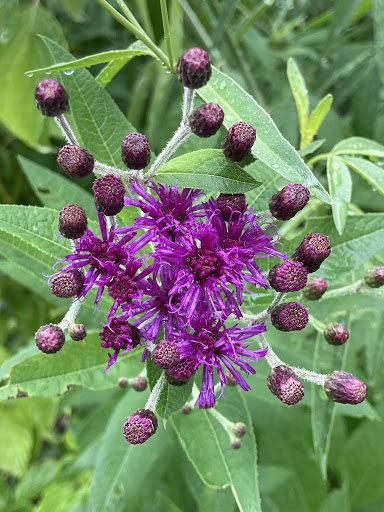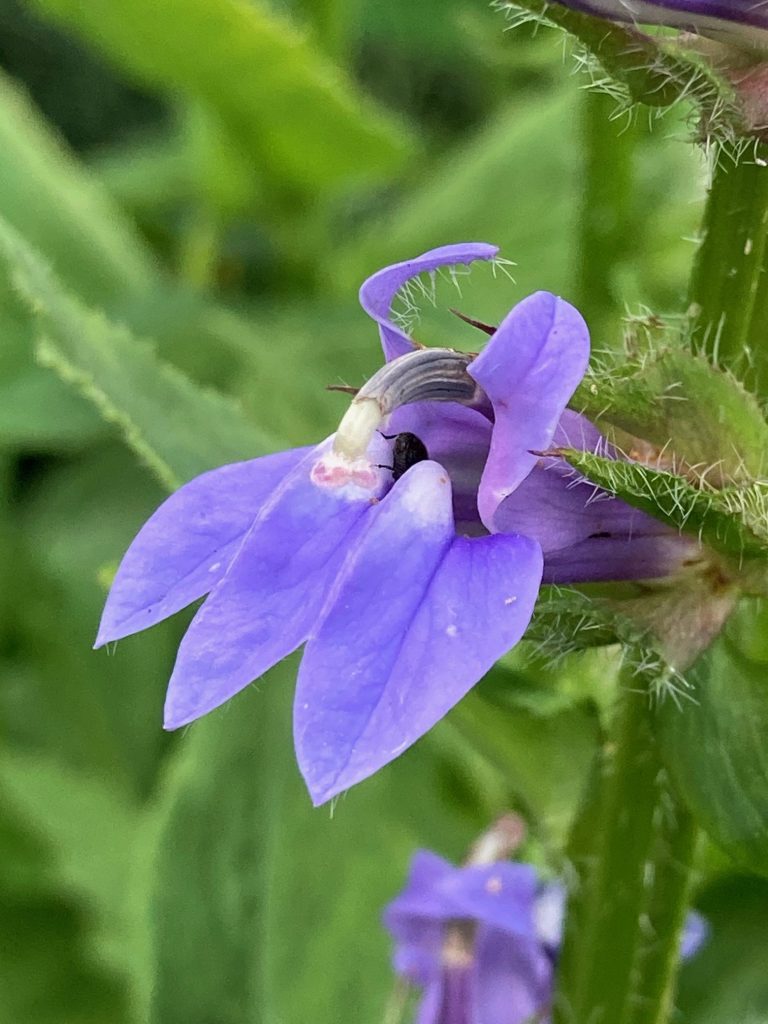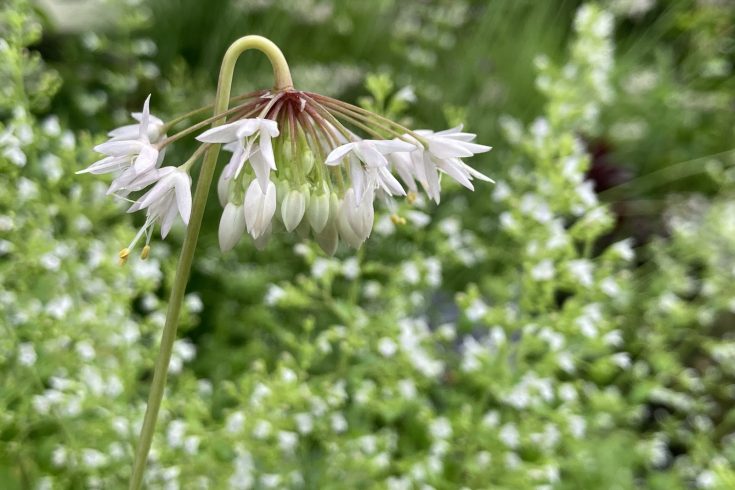
Clethra alnifolia ‘Ruby Spice’, or Summersweet ‘Ruby Spice’; is a sport of C. alnifolia ‘Pink Spires’, with darker pink blooms. In late summer and early fall its fragrant, bottlebrush flowers attract butterflies, bees, and other insects. This versatile shrub tolerates a full sun to full shade location and is native to the eastern USA. You can find this plant in the Westview Terrace.

Rudbeckia fulgida sullivantii ‘Goldsturm’ is commonly known as Brown Eyed Susan. It was the Perennial Plant Association’s Plant of the Year in 1999. Rudbeckia Goldsturm is very long blooming, is unbothered by insects or drought and should hold a spot in every garden! These floriferous, mid-summer blooming perennials continue blooming through fall which makes them a very popular perennial; with good reason. Found extensively through our Perennial Border.

Allium cernuum, commonly known as the Nodding Onion is a native edible plant, and true pollinator magnet. With its graceful arched neck and nodding flowers, its a beautiful addition to any garden. A perfect pollinator plant in the late summer. Spreading by bulb and seed, it’s light pink blooms are a welcome sight. Interesting fact – the city of Chicago gets its name from the Algonquin Indian name for this plant, chigagou. This plant is found throughout many of our gardens.

Amaryllis Belladonna is known to possess fragrant light-pink flowers, appearing in mid-August after their green foliage has died back, giving them the common name of “Naked Ladies.” Cold hardy in zones 7-11. They can be found tucked in the corner near the building of the Westview Terrace. Heat from the building in the winter keeps these plants from freezing in the winter.

With origins in Central America and Northern South America, this summer flowering annual is Gomphrena pulchella “Fireworks,” more commonly known as Globe Amaranth “Fireworks” or Gomphrena “Fireworks.” Introduced in 2009 by Ball Horticulture, this bloom certainly lives up to its moniker; looking like miniature fireworks as they bloom around the garden. The only thing they are missing is the BANG! Found at the along the main pathway adjacent to the Knot Garden. .

*Ontario Weed Profile* Black medick, Medicago lupulina, is often found in lawns and gardens is an annual weed that spreads readily by seed. Originally introduced to North America from Europe and Asia many years ago for agricultural purposes it escaped cultivation, as many of the plants we consider weeds today. Black medic seeds and leaves are edible. Plant historians believe that Native Americans may have roasted the seeds or ground them into flour. In Europe and Asia, the foliage was cooked much like collards or spinach. Bees are very attracted to the blooms which results in very flavorful honey.

Agastache foeniculum, commonly known as anise hyssop, is a short-lived perennial (known to reseed freely) in the mint family, native to parts of the upper Midwest and Great Plains (Wisconsin to Ontario, west to British Columbia, and south to Colorado) A pollinator magnet, this long blooming, beautiful plant can be found in our kitchen garden, attracting pollinators to the food garden, resulting in higher yields in the vegetable garden. An incredibly strong nectar producer, which bees and butterflies feast on, it is estimated that one acre can support 100 hives. Also known for building up bees’ honey reserves before winter due to its late season and prolific flowering. For humans; its leaves make a delicious tea. It was also used as a cough remedy by Native Americans.

Gomphrena globosa ‘Gnome Pink’ is a dwarf compact variety of Gomphrena. The more you look into the fine detail in the bloom the more you fall in love with the complex simplicity. Almost as if wearing a daisy crown, small white and yellow blooms add a certain whimsy.

Cats Whiskers (Orthosiphon aristatus) is native to tropical areas of Asia and has spread to the East Indies, Indochina and Indonesia. It is cultivated for Java Tea on the islands of Sumatra and Java. Only the leaves are edible and are widely used for herbal teas (Java Tea) in south-east Asia. The other parts of the plant are toxic.

Silphium perfoliatum, commonly known as the cup-plant, is native to eastern and central North America. Cheerful yellow blooms tower above head, often seen 8 to 10’ in the air. One of the interesting characteristics of this plant is the leaves ability to catch and hold rainwater at the stem, making it a frequent drinking spot for pollinators and hummingbirds after the rain. These are found in a few of our gardens.

Vernonia fasciculata, known as the Common Ironweed, is a stately native perennial, currently coming into bloom in the Nature’s Garden and Perennial Border. Looking for a beautiful native plant? Tall clusters (3’-6’) of purple stars is irresistible to late summer pollinators, frequently visited by many types of bees, and butterflies. The genus Vernonia is named in honour of William Vernon (d. ca 1711); an English botanist who collected plants in Virginia in 1698. The species fasciculata, means ‘grouped together in bundles’, which can be seen on the flower heads.

Similar to Salvia greggii in shape. The flowers of the cultivar ‘Hot Lips’ will be red, red and white, or white, depending on the temperature during flower bud formation; making this a unique plant, often having different degrees of red and white blooms on the same plant. How Canadian! …except that this plant is native to Mexico. You can find it tucked into the rock wall of the Westview Terrace, and is often visited by hummingbirds.

Helenium autumnale Mariachi Fuego. Hybridized by Arie Blom of AB-Cultivars in the Netherlands; this compact variety of Helen’s flower, as it is commonly known, is just starting to bloom in the entry garden. This flower starts in late summer and peaks in late early fall, when many other perennials have finished up for the year.

Vitex angus-castus, commonly known as the Chaste Tree, is a native of the Mediterranean Region. Only marginally hardy here, they die to the ground each year, instead of growing into the small tree they normally would. Since they flower on new growth, we still get to enjoy their beautiful blooms, which attract pollinating bees and butterflies. Found in the entry garden, the Chaste Tree is also known for its aromatic foliage.

Calamintha nepeta ssp. nepeta, recently named the 2021 Perennial Plant Association plant of the year. Great pollinator plant that blooms from early summer until Frost. Lovely light mint fragrance, noticed by many photographers leaning in to get the perfect photo of the many bees that visit. Found along the main pathway by the knot garden, as well as in the Westview Terrace.

Lobelia siphilitica (Great Blue Lobelia) is a North American Native, just coming into bloom in the terrace garden. A beautiful blue flower, irresistible to bees, hummingbirds, and butterflies; a great addition to any perennial border.

Aconitum ‘Stainless Steel’ was introduced in 1998, this cultivar is compact & more lush than the wild species, Aconitum cammarum – it is actually a hybrid of A. cammarum, and a Himalayan species, A. spicatum. Aconitum were grown in medieval times for use as poisons. Found in the entry garden away from the public reach; enjoy this one with your eyes only!
Photo Credit: Paul Gellatly




